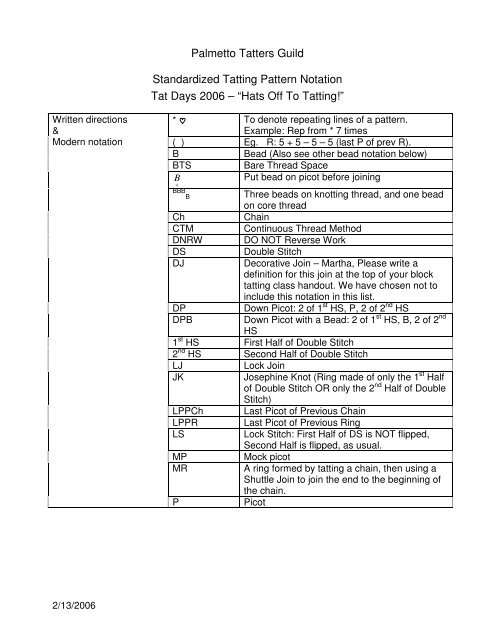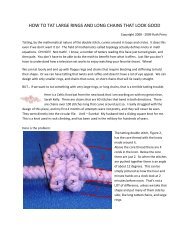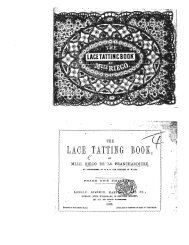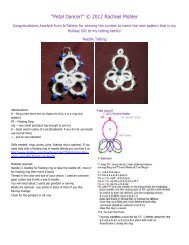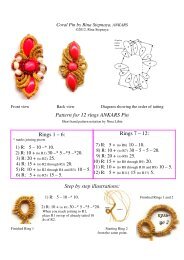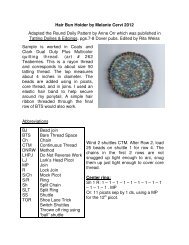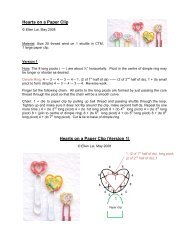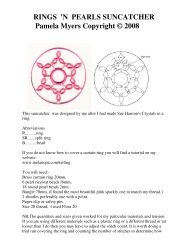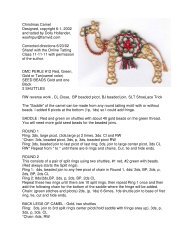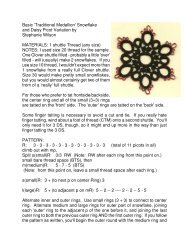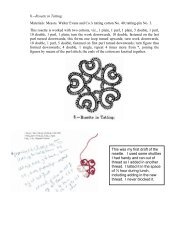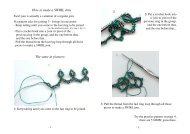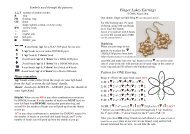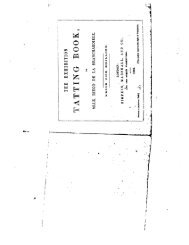Palmetto Tatters Guild Standardized Tatting Pattern Notation Tat ...
Palmetto Tatters Guild Standardized Tatting Pattern Notation Tat ...
Palmetto Tatters Guild Standardized Tatting Pattern Notation Tat ...
Create successful ePaper yourself
Turn your PDF publications into a flip-book with our unique Google optimized e-Paper software.
<strong>Palmetto</strong> <strong><strong>Tat</strong>ters</strong> <strong>Guild</strong><br />
<strong>Standardized</strong> <strong><strong>Tat</strong>ting</strong> <strong>Pattern</strong> <strong>Notation</strong><br />
<strong>Tat</strong> Days 2006 – “Hats Off To <strong><strong>Tat</strong>ting</strong>!”<br />
Written directions<br />
&<br />
Modern notation<br />
* To denote repeating lines of a pattern.<br />
Example: Rep from * 7 times<br />
( ) Eg. R: 5 + 5 – 5 – 5 (last P of prev R).<br />
B<br />
Bead (Also see other bead notation below)<br />
BTS Bare Thread Space<br />
B<br />
Put bead on picot before joining<br />
+<br />
BBB<br />
B<br />
Three beads on knotting thread, and one bead<br />
on core thread<br />
Ch<br />
Chain<br />
CTM Continuous Thread Method<br />
DNRW DO NOT Reverse Work<br />
DS<br />
Double Stitch<br />
DJ<br />
Decorative Join – Martha, Please write a<br />
definition for this join at the top of your block<br />
tatting class handout. We have chosen not to<br />
include this notation in this list.<br />
DP<br />
Down Picot: 2 of 1 st HS, P, 2 of 2 nd HS<br />
DPB Down Picot with a Bead: 2 of 1 st HS, B, 2 of 2 nd<br />
HS<br />
1 st HS First Half of Double Stitch<br />
2 nd HS Second Half of Double Stitch<br />
LJ<br />
Lock Join<br />
JK<br />
Josephine Knot (Ring made of only the 1 st Half<br />
of Double Stitch OR only the 2 nd Half of Double<br />
Stitch)<br />
LPPCh<br />
LPPR<br />
LS<br />
MP<br />
MR<br />
P<br />
Last Picot of Previous Chain<br />
Last Picot of Previous Ring<br />
Lock Stitch: First Half of DS is NOT flipped,<br />
Second Half is flipped, as usual.<br />
Mock picot<br />
A ring formed by tatting a chain, then using a<br />
Shuttle Join to join the end to the beginning of<br />
the chain.<br />
Picot<br />
2/13/2006
PLJ or<br />
‘PULLED LOOP’ join or<br />
‘PULLED LOCK’ join since it is actually a lock<br />
join made after placing thread under a finished<br />
ring and pulling this thread through a picot.<br />
The join connects one ring to another in a<br />
sequence of rings in ONE shuttle tatting. Not<br />
very good for plain tatting because of a visible<br />
bare thread, but extremely useful for tatting<br />
with beads, see:<br />
A. Crichlow’s Let’s <strong>Tat</strong>, 1978 and N. Libin’s<br />
One Shuttle, Lots of beads, 2004…<br />
It is also known as a ‘CARRY THREAD’ join<br />
in A. Crichlow’s Let’s <strong>Tat</strong> or a ‘CARRY<br />
THREAD UNDER A RING’ join in Kliot’s A<br />
<strong>Tat</strong>ter’s Workbook.<br />
R<br />
Ring (made of Double Stitches)<br />
RW<br />
Reverse Work<br />
SCMR Self-Closing Mock Ring: A Ring made as if<br />
making a chain, but closed by dropping Shuttle<br />
through a Core Thread loop to close.<br />
Example: SCMR 4 – 4 [3 – 3 – 3 – 3 .] 4 – 4.<br />
SCh Split chain<br />
Sh1<br />
Shuttle 1 – define which is Shuttle 1 at the top<br />
of your handouts, if needed<br />
Sh2 Shuttle 2<br />
ShA Shuttle A (if you prefer letters to numbers)<br />
SLT Shoe Lace Trick or Tie<br />
SR<br />
Split Ring<br />
Example: SR 5 – 5 / 5 – 5.<br />
SSh Switch Shuttles<br />
SwJ Swirl Join: put a crochet hook into the picots of<br />
all the rings to be connected (3 or more), pull<br />
the knotting thread through all those picots and<br />
make a regular join<br />
Turn Turn: a side-to-side motion, rather than up-anddown<br />
as for Reverse Work.<br />
VSP Very Small Picot<br />
VLP Very Long Picot- length should be given for an<br />
‘open’ picot. Example: VLP = 1” This means<br />
the tatter should use a 1” picot gauge vertically,<br />
so that the finished picot length is ½”.<br />
WUJ Wrap Under Join: or ‘Alligator’ join (place a<br />
core thread under a marked place on a chain<br />
and continue tatting).<br />
2/13/2006
Long hand written<br />
instructions<br />
Bet<br />
Cl<br />
J<br />
P<br />
Prev<br />
Rep<br />
Sep<br />
Between<br />
Close (ring)<br />
Join<br />
Picot<br />
Previous<br />
Repeat<br />
Separated<br />
Modern notation<br />
+ Join<br />
– Picot<br />
–– Long Picot<br />
. Close Ring or shape Chain<br />
( ) <strong>Pattern</strong> instructions to be repeated<br />
X# Number of repetitions to be completed<br />
The symbols below are made in Smart Draw, a program compatible with MS WORD,<br />
which means that everyone can copy it from this list and paste into their document. The<br />
image can be enlarged or made smaller to fit into the text by using the Format menu in<br />
WORD (Format> Object> Size).<br />
1 bead on the knotting thread<br />
1 bead on the core Thread<br />
3 beads on the knotting thread to make a<br />
‘POINTED’ picot<br />
1 bead on the knotting thread & 1 bead on<br />
the core thread<br />
2 beads on the knotting thread and 1 bead on<br />
the core thread<br />
3 beads on the knotting thread and 1 bead on<br />
the core thread<br />
For ‘Block’ tatting with<br />
beads<br />
1) or 2) 2 beads on the knotting thread and 2 beads<br />
on the core thread<br />
3)<br />
4) , etc.<br />
Each of the Symbols 2), 3), 4) above can be copied and pasted as a whole, or built up using<br />
as in Symbol 1)<br />
2/13/2006
Symbols for graphical → start here<br />
patterns ⊗Jk Josephine knot<br />
Example: ⊗ Jk 12<br />
Ring<br />
bare thread space<br />
Chain<br />
decorative picot<br />
joining picot<br />
Number of Double Stitches between picots<br />
Split Ring<br />
Split Ring with a Bead in the middle<br />
Split Chain<br />
2/13/2006


